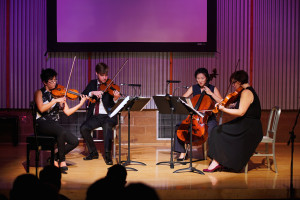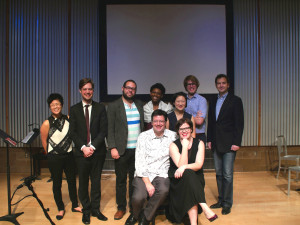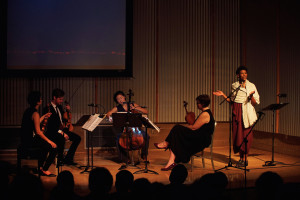 On Saturday, February 27, 2016 Boston Court in Pasadena hosted the Los Angeles-based composer collective Synchromy and The Argus Quartet who performed no fewer than 9 works of new music including three world premieres. A nice crowd filled the Marjorie Branson space to hear a concert titled walkabout that featured narration, video projections and music from seven different composers inspired by place and surroundings.
On Saturday, February 27, 2016 Boston Court in Pasadena hosted the Los Angeles-based composer collective Synchromy and The Argus Quartet who performed no fewer than 9 works of new music including three world premieres. A nice crowd filled the Marjorie Branson space to hear a concert titled walkabout that featured narration, video projections and music from seven different composers inspired by place and surroundings.
The first piece on the program was Sabina, by Andrew Norman from A Companion Guide to Rome, a collection of nine musical portraits based on churches in Rome. As Norman writes in the program notes: “The music is, at different times and in different ways, informed by the proportions of the churches, the qualities of their surfaces, the patterns in their floors, the artwork on their walls, and the lives and legends of the saints whose names they bear. The more I worked on these miniatures, the less they had to do with actual buildings and the more they became character studies of imaginary people, my companions for a year of living in the Eternal City.”
Sabina was performed on this occasion by Clara Kim of the Argus Quartet as a violin solo. This begins with a series of quiet whispers that evoke a light breeze or the wind whistling softly through the stone arches of a church. This builds gradually into some lovely notes and runs of sound that unfold to create a more active, complex texture. The playing becomes more animated through an interweaving of sounds – much like a tapestry of colored threads – but with an overall warmth and wistfulness that is very appealing. All of this was performed with great skill by Ms. Kim who kept everything balanced and moving crisply forward. Towards the conclusion the pace slowed and a series of singularly high, thin notes coalesced into what could have been a simple hymn tune to finish out. For those who are familiar with Norman’s orchestral works – full of power and fury – Sabina reveals a more sensitive compositional touch and is a beautifully sketched likeness of a charming subject.
Cloud Trio, by Kaija Saariaho was next and a brief spoken introduction by narrator Chelsea Fryer was given about the instrumentation prior to the playing of this piece. As quoted from the program notes: “In this piece, the three instruments all have different tasks and functions, they represent very different aspects of string playing. These tasks are sometimes very concrete: the violin tends to behave as an echo or reverberation, the viola creates new clouds next to the existing ones and the cello often has a function of a shadow to the upper instrumental lines.”
Images of clouds moving slowly across a blue sky were projected on the screen above the stage and Cloud Trio began with smooth, sustained lines from each instrument that produced some enchanting harmony. As the piece progressed there was a more active feel in the violin – almost like the falling of rain drops – and a rapid, complex intertwining of the parts. Over the four sections of this work each of the instruments rose to the top of the texture only to be replaced with another, and this produced a fascinating series of combinations. The volume, rhythm or complexity would increase and then subside, and the feeling was variously mysterious, lethargic or dramatic, as if a series of different clouds were drifting by. A captivating violin solo emerged just as the piece finished and the Argus players carefully drew out each of the nuances in this well-played performance. Cloud Trio is imaginative music that invites the listener to conjure up vivid atmospheric images.
The world premiere of funeral song for the people of the ruined cities, by Zaq Kenefick followed and for this piece the full Argus Quartet took the stage. This music is an exploration of what hypothetical folk music might sound like for a people who have lost their cultural memory after some long-ago calamity. A short narration preceded the start of this and an anxious trill in the violin opened the piece with a strong sense of foreboding. Tutti passages followed with a growling sound in the cello and strong strumming of the viola. There is a rough, edgy feel to this – all is unsettled and seemingly in chaos. Despite its short playing time, funeral song for the people of the ruined cities is an expressive and unnerving musical glimpse into the grim future of a people who must exist without a past.
The last piece of the first half of the concert was another world premiere, Skronk, by John Frantzen. The term ‘skronk’, as explained by narrator Chelsea Fryer, is omnibus street slang for all sorts of activities – often used pejoratively or sometimes as a compliment. Frantzen reports that his relocation to New York added a new set of skronk inspirations and influences not previously available in his former rural home. The piece opens with a lively pizzicato that delivers a sense of rapid movement and continuous activity. The uptempo feel and groove is distinctly urban, and solos by the violins add to the sense of motion and purpose. The infectious rhythms and complex texture compliment the driving beat and the playing here by the Argus Quartet was invigorating, yet precise. Skronk nicely captures the intensity and excitement of a casual stroll through a colorful New York neighborhood.
After an intermission, three more excerpts from Andrew Norman’s A Companion Guide to Rome were heard. Teresa began with a frantic scramble of notes from the string trio, full of fiery passion and intense emotion – we have all probably met that Italian woman. The rhythmic free fall continued throughout and was an amazing phenomenon, very powerfully played. Clemente was the exact opposite; calm and quiet as a rooftop garden with the violins evoking bird calls and the buzzing of insects. The rustic feeling was made complete with the sound of a rusty gate heard in the lower strings as this section concluded. Pietro followed with a bouncy pizzicato, full of syncopated rhythms that perfectly captured the skipping of a child at play. All of the sections from A Companion Guide to Rome were artfully performed, with the subtlety and character of each carefully portrayed by the members of the Argus Quartet.
The world premiere of String Quartet No.1: London, by Nick Norton, followed and this consisted of three movements beginning with Brilliant, shimmering, which proved to be just that. Opening with a lively beat in the violins and offset by solid beats below, this first movement unfolded with a series of intriguing textures that included a light rapping of the violin bows on the strings. A bright intensity and drama increased throughout this section with the violins adding a touch of anxiety before concluding on a quiet chord. Largo followed and this had a wonderfully dark coloring in the slow, sustained tutti sections – providing an excellent contrast with the opening movement. At times the texture thinned out into a quiet, almost eerie feeling, but returned to more deliberately satisfying and solid chords at the finish.
Ethereal was the final movement and this featured a lovely, airy feeling from sustained tones in the viola and violins that arrived like puffs of a light breeze against the counterpoint in the cello. The texture seemed to float in the air with no visible means of support, building upwards like a fleecy cloud rising in the sky. This was carefully and closely played by the Argus Quartet who drew out all of the introspective subtlety and nuance. The contrast between the busy cello and viola parts with more sustained tones in the violins was especially effective. Ethereal floats along enchantingly and then suddenly and unexpectedly concludes on a rush of tutti pizzicato notes that bring this work to a close. String Quartet No.1: London, although dating from Norton’s student days, is a strong work full of vibrant color and refinement that skillfully invokes a wide range of expressive feelings and emotions.
More postulated folk music from Zaq Kenefick was next in the form of the world premiere of harvesting tunes of the people of the rope-tree towers. This began with low, scratchy tones from the violin and viola, in full distortion mode, while a high arco violin was accompanied by smooth cello tones below. Scenes of what seemed to be an alien landscape were projected on the screen and this added to a building sense of grim despair. The sadness continued and the feeling in the music became even more bleak and discouraging. The scratchy viola ceased and a low, solemn passage followed to end this piece. harvesting tunes of the people of the rope-tree towers is a cautionary reminder of what can result from the loss of civilized traditions and common artistic remembrances.
Excerpts from Leyendas: an Andean Walkabout, by Gabriela Frank followed. The program notes describe this work as one that “… draws inspiration from the idea of mestizaje as envisioned by the Peruvian writer José María Arguedas, where cultures can coexist without the subjugation of one by the other. As such, this piece mixes elements from the western classical and Andean folk music traditions.” Three movements were performed by the Argus Quartet and photos of different Peruvian scenes were projected on the screen above the stage. Tarqueada, the first excerpt, had an active and exotic feel, full of strongly phrased rhythmic passages and engaging harmonies. Rapid and skillful playing, along with good interplay between the violin lines and the cello agreeably evoked the image of a swirling street scene. A lighter touch prevailed in the second selection, Himno de Zampoñas, inspired by a type of pan pipe ensemble. There was a courtly and delicate feel to this at times, arising from the rhythmic pizzicato of the violins playing against the darker cello and viola tones. Chasqui was the last excerpt and this was inspired by the athleticism of the Inca messengers who ran along the remote mountain trails bringing news to the villages. The fast rhythms in the opening suggested constant movement and running while later violin solos added a tinge of loneliness to the color. The tight ensemble of the Argus Quartet brought the necessary accuracy to bear on the sketching of this intriguing character. Leyendas: an Andean Walkabout is vividly written portrait of an exotic culture as seen through the lens of the traditional European string quartet.
The final piece on the program was Testy Pony, by Eve Beglarian and this featured an accompanying video by Jason Barabba while the poem of the same name by Zachary Schomburg was read by the narrator. Recorded sounds were heard from a speaker on stage and cellist Jo Whang played a live solo. The video showed a horse variously walking or trotting and the cello playing was nicely set against the recording. The music had something of a sadness to it but was succeeded by a more redemptive feeling towards the finish, perfectly matching the arc of the poem. The playing by Ms. Whang was strong and smooth, giving Testy Pony just the right balance of imagery, words and sound.
 Walkabout was a skillfully played and astutely programmed concert that provided a full evening of exotic travel and imaginative original music.
Walkabout was a skillfully played and astutely programmed concert that provided a full evening of exotic travel and imaginative original music.
The Argus Quartet is:
Jason Issokson and Clara Kim, Violins
Diana Wade, Viola
Jo Whang, Cello
With Chelsea Fryer, Narration
Photos by Adam Borecki

